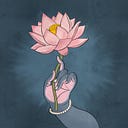Art History: The origin of “Composite Animals” in Deccan paintings
Though popularly thought to be of Mughal origin, inspired by Persian miniatures, composite art has been noticed from traditional sculptures, miniature paintings, illustrated manuscripts etc. as early as it 12th century A.D. to the modern period, including in Andhra and even Bengali art. The antelope, elephant, horse, parrots, and other mythical figures and paintings have been represented. Temples are the best places for composite art to be seen in sculpture and architecture. A fine example for composite nature of carving is known from the Mahānandi Temple from 12th century A.D. in Kurnool, Andhra Pradesh, where one pillar represents five women forming the shape of a horse, popularly known as pañcha-kalyāṇī. On another pillar, three women from a parrot. In the later period, it is seen that nine women from the shape of an elephant upon which Kṛṣṇa is seen riding — called ‘navanārī-kunjara’.
The architectural remains at Anegondi, now a small village situated on the northern bank of the Tungabhadra river, the first capital (c.1336–1368) of the Vijayanagara rulers who reigned on the most powerful Hindu empire of South India between the 14th and the 16th centuries, is imbued with mythological significance.
The Anegondi ruins date back to the 12th and 13th centuries. Composite animal figures are seen painted on the ceiling of the Uchappaya Matha, a dilapidated two-storeyed structure to the south of the village, which is of interest for the fragments of Vijayanagara paintings preserved on the ceiling beams.
Thanjavur, ca. 1825; Ink, opaque watercolor, and gold on paper
Nine ornately dressed and bejeweled female dancers form the body of the elephant, serving as mount to a green-skinned archer wearing a golden crown, recalling the deity Kama.
In ‘A Survey of Painting in the Deccan’, Stella Kramrisch wrote, “The one panel, inscribed, has a bearded rider with long hair on an elephant made of five women, preceded by a woman waving a cloth. Lotus garlands are suspended from the top. The other panel has a similar rider on a horse, composed of five women, lotuses suspended and scattered over the surface; in front, a woman with bouncing step carries an umbrella, another at the back of the horse, a fan.”
These characteristic animal figures, made of humans, demons, and real and mythical creatures became a common theme in Persian, Mughal, and Deccani drawings and paintings later on, in the 16th and 17th centuries.
Sources: Composite Art: with special reference to the miniature paintings in Salar Jung Museum by Balagouni Krishna Goud and M.V.S. Sarma (jstor)
